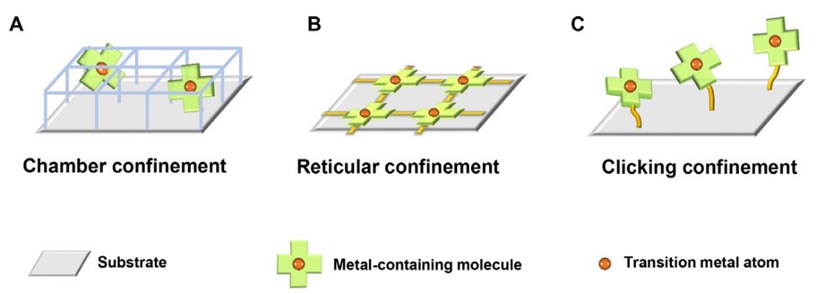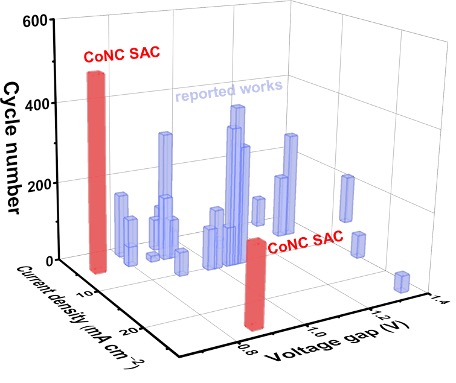| Mar 17, 2022 | |
Clicking confinement strategy as new breakthrough in fabricating single-atom catalysts |
|
| (Nanowerk Spotlight) High-efficiency energy storage, represented by rechargeable batteries, lays one of the foundations of modern society. | |
| Rechargeable zinc–air batteries are one of the next-generation techniques to substitute the current lithium-ion batteries technology, considering their ultrahigh theoretical energy density, inherent safety, and low cost. | |
| However, the cathodic reactions in zinc–air batteries are very sluggish in kinetics, requiring high-performance electrocatalysts. Recently, single-atom catalysts, with 100% atomic utilization efficiency, have emerged as promising electrocatalysts for zinc–air batteries. | |
| “Unfortunately, the fabrication of single-atom catalysts remains a challenging issue,” Qiang Zhang, a Professor at Tsinghua University, tells Nanowerk. “The key to fabricate single-atom catalysts is the confinement of transition metal atoms in the precursor, which is indeed a critical challenge.” | |
| The current approaches to confine transition metal atoms toward the fabrication of single-atom catalysts can be mainly classified into two categories: the chamber confinement strategy and the reticular confinement strategy. | |
| Despite the above attempts in single-atom catalysts fabrication, novel synthesis methodologies are expected to enrich the structural design of precursors to offer new opportunities in advanced single-atom catalysts fabrication. | |
| Addressing this critical challenge, a research team from Prof. Qiang Zhang at Tsinghua University and Dr. Bo-quan Li at Beijing Institute of Technology recently proposed clicking confinement strategy as a new synthesis methodology towards the fabrication of single-atom catalysts. | |
| The related research results, first-authored by Chang-xin Zhao, have been published in Science Advances ("A clicking confinement strategy to fabricate transition metal single-atom sites for bifunctional oxygen electrocatalysis"). | |
 |
|
| Figure 1. Different strategies to fabricate single-atom catalysts. Schematic representation of the current A) chamber confinement strategy; B) the reticular confinement strategy; and C) the novel clicking confinement strategy. (Image courtesy of the researchers) | |
| “Click chemistry, aiming to achieve quick and reliable organic synthesis through the splicing of small units, is one of the most useful and attractive organic synthesis methodologies,” explains Chang-xin Zhao, a doctoral candidate at Tsinghua University. “Under the guidance of click chemistry, we propose the clicking confinement strategy to ensure efficient confinement of the metal atoms to consequently construct single-atom sites – definitely an encouraging innovation.” | |
| For the demonstration of the clicking confinement strategy, cobalt porphyrin units are clicked onto a conductive substrate through an amination reaction to form the precursor toward the fabrication of cobalt-based single-atom catalyst. | |
| The fabricated single-atom catalyst exhibits excellent electrocatalytic activity with an indicator ΔE of 0.79 V, outperforming most of the reported single-atom catalysts. The fabricated single-atom catalyst further enables zinc–air batteries with remarkable electrochemical performances, including a low voltage gap of 0.83 V and stable 200 cycles at a high current density of 25 ma cm−2. | |
 |
|
| Figure 2. Zinc–air battery performance comparison regarding the cycling current density, voltage gap, and cycle number of the fabricated catalyst (CoNC SAC) and other reported catalysts. (Image courtesy of the researchers) | |
| “Clicking confinement strategy, as a new synthesis methodology, is inherently distinct from the conventional strategy, namely the chamber confinement and the reticular confinement strategy,” says Dr. Bo-quan Li, a young researcher focused on advanced energy materials. “It's not an exaggeration to call it a huge breakthrough in the fabrication of single-atom catalysts." | |
| The clicking confinement strategy possesses several advantages compared with conventional strategies: | |
|
|
|
| The next stages in the team's investigations will extend this novel synthesis concept to other types of advanced single-atom catalysts and their applications to other energy-related devices to fully validate the intrinsic advantages of the clicking confinement strategy. | |
| Provided as a Nanowerk exclusive by Prof. Qiang Zhang’s Team, Department of Chemical Engineering, Tsinghua University | |
|
Become a Spotlight guest author! Join our large and growing group of guest contributors. Have you just published a scientific paper or have other exciting developments to share with the nanotechnology community? Here is how to publish on nanowerk.com. |
|
